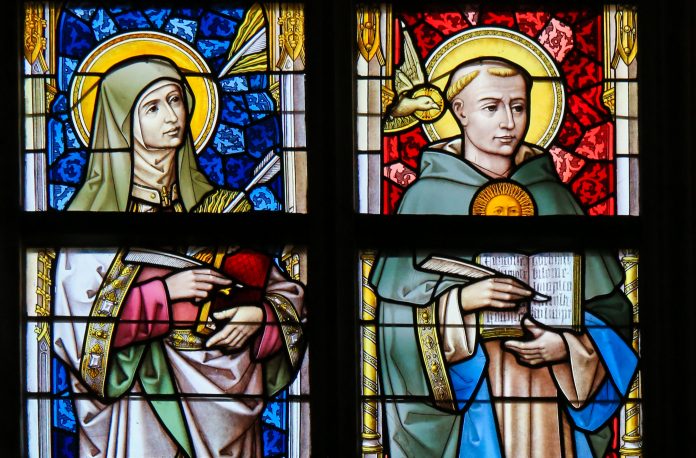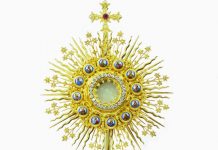
by Jeanne Heiberg
On March 19 the Church honors St. Joseph, Husband of the Blessed Virgin Mary. This solemnity honors Joseph as the foster father of Jesus and protector of the Holy Family. Joseph was a good worker. He used his hands and the tools of his carpentry trade to provide for his family. In doing so, he also met the needs of the community in which he lived.
Because the catechetical theme for this year is “Matrimony: Sacrament of Enduring Love,” it’s a great time to honor Joseph and celebrate fatherhood. But let’s go further. Let’s also celebrate Mary and Jesus and their extended family members. Let’s celebrate our own family, too, and familyhood—in which each family member plays a special role. The Holy Family shows us what is needed for successful familyhood: obedience to God, living God’s will of love, carrying out one’s special role, and caring for one another.
Joseph and Familyhood
Joseph shows us what it means to be a father—in his faith and in his behavior. Scripture shows Joseph as a kind, merciful, and righteous man. When Mary is found with child before she became his wife, Joseph could have exposed her, taken her before the law—harsh in those days. Joseph thinks to “divorce her quietly” (Matthew 1:19). Mary could have been seriously punished.
That he listens to the angel of the Lord in a dream shows Joseph to be a sensitive man who prays and who listens to God. That he does what the angel says in this and later dreams (Matthew 2:13-14; 19-22) shows he is a man obedient to God.
Other Scriptures show Joseph to be a poor man who can afford only sacrificial doves when Jesus is presented in the temple (Luke 2:22-24). He is a worker—a carpenter (Matthew 13:55) who teaches Jesus the same trade (Mark 6:3). He provides for his family in Egypt, Bethlehem, and Nazareth so that while not rich, they have what they need.
The virtues of Joseph as father and worker were brought to my attention when I went to St. Rocco School in Newark, NJ, to learn how to teach Whole Language for a program that helped young children stay in school and dropouts get back on track.
When I arrived at St. Rocco’s and was welcomed into a Whole Language classroom, I noticed there were only girls in the room. It was March 19 and all the boys were in a special assembly in honor of St. Joseph. Saint Rocco’s pastor was teaching them about what it means to be a man, with St. Joseph as example and role model. I thought it was wonderful that these boys were given a great role model for their future roles as men, workers, and (for most) fathers.
Mary and Familyhood
Mary has always been a model for girls and women. Her faith and obedience to God has often been honored. She made her fiat—said “Yes”—when the angel proposed something most would think impossible: becoming pregnant without a human father (Luke 1:26-38). In this condition, Mary rushes to help her cousin, Elizabeth, when she hears Elizabeth is about to become a late-in-life mother. When the two family members meet, Mary shows humility, gratitude, and deep faith in her great Magnificat song (Luke 1:46-55). And with the events of Jesus’ birth, Mary, a woman of prayer, “kept all these things, reflecting on them in her heart” (Luke 2:19, 51).
When Jesus was an adult, Mary again shows deep faith, wisdom, and discernment at the wedding feast at Cana, when she says to the servants (and to all of us), “Do whatever he tells you” (John 2:1-5).
From the words of her neighbors about Jesus—“Is this not the carpenter’s son? (Matthew 13:55)”—we know that Mary, Joseph, and Jesus himself were seen as ordinary people. Mary did all the things considered to be part of a woman’s role in that time and culture. She created a home and nurtured life before the birth of Jesus—and long after. She served meals to her own small family and likely to her cousins, aunts, uncles, and others who came to visit.
As some gender roles now overlap, society is becoming more aware of the need for two parents nurturing life in the home, as both also work outside the home to provide for family needs. Today, Mary is a role model for boys and men as well, as Joseph is a model for girls and women.
Jesus and Familyhood
Mary and Joseph search through the pilgrim caravan leaving Jerusalem when they discover Jesus is not with them or any of their extended family. Panic! They both return to the city to hunt for him—and they find him in the Temple.
Scripture shows Mary’s and Joseph’s confusion and consternation in discovering their missing 12-year-old conversing and holding his own with the country’s wisest and most learned teachers. It is obvious that Jesus studied well and was preparing for his future. His words—“Did you not know that I must be in my Father’s house?” (Luke 2:41-52)—tell us he is searching for who he is, what his vocation is. He is already obedient to his Heavenly Father, listening and learning. When Mary and Joseph find him, he returns to their home in Nazareth and “was obedient to them” (Luke 3:51).
The time in the Temple was only a foretaste of Jesus’ universal—and eternal—role, but he was already becoming alert and sensitive to what God asked of him. Jesus gives an example of a child’s role in the family.
At the beginning of life, the child brings joy and hope. Most births don’t include angels singing and shepherds and kings visiting, but relatives and friends come to dote on the newcomer. As the child develops, he or she is considered wonderful—no matter how many mistakes the child makes. My 99-year-old mother recently said to me, “You brought us so much joy,” and repeated something I said at the age of two or three: “Wanna see me ’kip?” Early, imperfect words and showing off new skills like walking, skipping, reading, and writing all bring freshness and excitement to parents.
As children grow and learn, their role in the family continues to unfold. Like Jesus, children study well and search for how they can “be about my Father’s business” and develop their gifts to serve God and others. They learn from others, especially great men and women with knowledge and wisdom. They search for and realize who they truly are—God’s sons and daughters as well as children of their earthly parents.
God is the ultimate head of the human family, but God is too great for us to comprehend and understand. However, in the Holy Family accounts, we find more touchable and imaginable role models. Jesus, Mary, and Joseph went through the same struggles we do. They experienced disruptions, changes, and dangers, but God always brought them through. Without prayer, attention to God, trust, love, and mutual help, they never would have made it. They are our examples of what familyhood means for us today.
Say to the Children
In celebrating the feast of St. Joseph, let’s learn from him about fatherhood. He was strong and brave and trusted in God. He took good care of those entrusted to him.
The Bible shows Joseph as a man of prayer. He listened to God and was obedient to God. He was kind to Mary and Jesus. He protected them in difficult, dangerous, and chaotic times, and found safe places for them to live.
As you grow up, you can learn to be strong, brave people who trust in God and take care of others. God will always help you fulfill your responsibilities.
Let’s also learn from Mary about motherhood. She took good care of her family and said “yes” to what God asked of her—even though she had no idea where that “yes” would lead. Mary trusted in God. She gave him praise and thanks. She prayed, meditated, and pondered in her heart events that she and her family experienced. Her Magnificat shows her as a loving, wise, and humble woman.
As you grow, you can learn to say “yes” to God, even when life asks difficult things and you can’t see what lies ahead. You also can praise and thank God in prayer and bring to God the events of your life for guidance and clarity. That way, you, too, will learn to take care of those entrusted to you.
As always, we learn from Jesus what it means to be a child of God. We also learn about the role children play in a family. Children often bring joy to their parents by being loving, helpful, and obedient. Part of their job is to discover their talents, gifts, and skills, and how God wants them to use their talents, gifts, and skills in service to others. At the age of 12, when Jesus is found in the Temple in Jerusalem by Mary and Joseph, Jesus said to them: “Did you not know that I must be in my Father’s house?” Yet, Jesus continued to obey his parents.
Balancing obedience while discovering your own gifts to serve God and others is an important job of growing up. (Use previous information suitable for your children’s age and experience).
Our families—no matter who lives in our household or where our family members live or how they are related to us—have much to learn from the Holy Family. Like Jesus, Mary, and Joseph, we can celebrate the grace of God that blesses all families—when they’re happy or sad or working together or struggling to get along.
To celebrate St. Joseph and familyhood, let’s make symbolic figures of family members. If you choose to make St. Joseph, know that he is the patron saint of workers, often shown with a carpenter’s tool such as a hammer, a saw, or a right-angle straight edge.
If you choose to make Mary, you may want to show her with a bowl, spoon, pot, or broom. She learned reading from her parents, so you may want to show her with a scroll.
If you choose to make Jesus, showing a book or a scroll is also appropriate, for Jesus studied and loved God’s word. He learned carpentry from Joseph, so a tool would also be appropriate.
Or you may want to make figures representing your own family today, using appropriate symbols. You can add hearts, suns, flowers, etc. to show family love and joy.
Familyhood Craft
MATERIALS
* 9”x 12” pieces of construction paper, one for each figure
* smaller pieces of construction paper and tissue paper
* cord
* scissors
* glue or glue stick
* staplers
* patterns [CLICK HERE]
Note: Encourage students to design their own facial features, clothes, hair, etc.
PROCEDURE
1. Roll the piece of construction paper into a cylinder that stands vertically and staple top and bottom. (Younger children will need assistance from you or an aide or older student.)
2. Cut out a small circle for the head and draw a face on the head. Or cut separate pieces for eyes, mouth, nose, and other features and glue them to the head.
3. Glue the head to the top part of cylinder.
4. Arms can be made by attaching to the sides of the figure smaller cylinders of construction paper, pieces of paper folded in half length-wise, or a single rectangle. Add hands if desired.
5. Use cord as a belt or other accessory.
6. Place symbol of the person on hands, arms, or on the figure itself.
Tips: A semi-circle or long strip of cloth or a paper towel makes a veil for Mary and other clothing. Art tissue makes more flowing veils and clothing—hair, too. A wood skewer with the point clipped off or a chopstick makes a staff for Joseph. Use football-shapes with black circles (cut and pasted or drawn with marker) in center for eyes. Use a circle or horizontal oval cut in half or upturned at the ends for mouth/lips. Hair and beards can be solid or fringed pieces of paper or yarn.
Familyhood Prayer
Opening Song: “Love One Another” © 1987, Robert J. Dufford, S.J. Glory and Praise Classic Edition, OCP
Opening Prayer: Thank you, Loving Creator, for giving us the example of Jesus, Mary, and Joseph as family role models. Help us to be faithful to our own family roles and to find joy in family. When there are imperfections and mistakes, may we forgive both others and ourselves and strive to make things better. May we appreciate the gifts of others and help one another grow as your children.
All: Amen.
Readings: Romans 8:14-17 (we are children of God); Matthew 2:13-14, 19-23 (Joseph listens to God); Luke 1:38 (Mary’s yes); Luke 1:46-55 (the Magnificat); Luke 2:51-52 (Jesus is obedient to Mary and Joseph); John 2:5 (Mary says, “Do whatever he tells you”)
Blessing: Lord Jesus, bless these symbols of family. May they help us love and cherish family members and all the family groups of which we are a part. (Bless the crafted figures with the sign of the cross.)
Help us to learn from you, Jesus, and from your earthly mother and father, to trust and obey our heavenly Father. May we learn to live God’s will of love and to care for one another in all our families.
All: Amen.
Closing Song: “Where Charity and Love Prevail” (Ubi Caritas). Text translated by Omer Westendorf. Music, Paul Benoit, OSB © 1960, World Library of Sacred Music
Jeanne Heiberg is the author of Advent & Christmas Crafts (Paulist Press) and Advent calendars (Creative Communications). She has taught art, writing, creative catechetics, meditation, and has directed parish catechetical programs.
Copyright 2011, Bayard, Inc. All rights reserved. This article is protected by United States copyright and other intellectual property laws and may not be reproduced, rewritten, distributed, redisseminated, transmitted, displayed, published or broadcast, directly or indirectly, in any medium without the prior written permission of Bayard, Inc.
This article was written by the Catechist Staff and appeared in Catechist magazine, February 2011.
Image Credit: jorisvo/Shutter Stock 544541167




